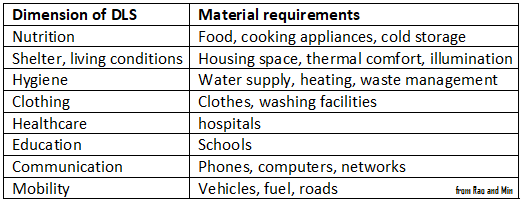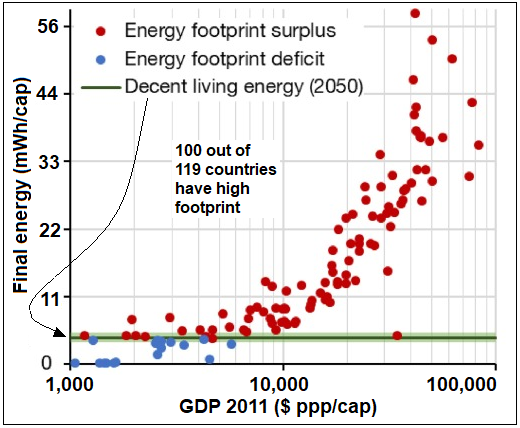Life in 2050 can be essentially the same with energy consumption at the level of the1960s, says S.Ananthanarayanan.
Pleas to cutting down on consumption, to save the planet, are met with the question, “would you like to go back and be cave dwellers?”
Joel Millward-Hopkins, Julia K. Steinberger, Narasimha D. Rao and Yannick Oswald, from the Universities of Leeds, Lausanne and Yale, and the International Institute for Applied Systems Analysis in Ladenburg, Austria, describe in the journal, Global Environmental Change, a study that shows that comfortable and modern, but sustainable living is entirely within reach. If the planet is being pushed over its limits, it is because of avoidable waste and not the essentials, the study shows. It is possible, the study shows for the world population, in 2050 to have shelter, mobility, food, hygiene access to healthcare, education and the Internet, with less than 40% of the current energy bill
The total energy, including food and fuel, used by a person in the later Stone Age, some 12,000 years ago, was under 300 kWh, in a year, the paper says. By 1850, with the growth that agriculture enabled, this figure rose to some 5,600 kWh, a 20-fold increase. And now, after 170 years of fossil fuel driven development, the total energy the world consumes is some 180 million GWhs, which comes to around 23,000 kWh for every person. And the attendant harm to the environment and climate change.
A question arises, has this rise in energy consumption made for better quality of life? During most of the first 10,000 years of agriculture, the paper says, most populations had a harder time than their forager ancestors. While this changed in recent centuries, with all round improvements in health indicators, the paper wonders whether our current situation is really better than that of the ancient foragers. While ancient societies were socially and politically quite sophisticated, unlike what is often assumed, there are some things about modern society, the paper says, that can be said with certainty:
1. The levels of energy use have led to scarcity of resources and geopolitical instability, in a growth-dependent economy – with the poorest the worst affected
2. There has been great improvement in efficiency of industrial processes, but these have mainly enabled more production, and more growth
3. There have been huge, recent increases in energy consumption, but with meagre social returns. Still, “some countries achieve high social outcomes with far lower energy consumption than others, but none currently manage to achieve high social outcomes while staying within planetary boundaries,” the paper says.
While it is clear that we need to cut down our energy use, it also appears possible to cut energy use without affecting our state of well-being. But does this mean we go back to primitive living? No, not even if we wished to, as primitive foraging cannot cater for the current global population, and there are cultural and technological realities that need to be provided for. The question, then, is what is that reduced level of energy we need, for well-being, with the comforts and conveniences of modern living?
The authors refer to recent attempts to make this estimation, and the belief that, despite the variety of cultural, historical and technological factors, one can identify a set of satiable needs, which apply to all, that lie at the base of human satisfaction. The authors make use of a study, “Decent living standards: material prerequisites for human wellbeing,” by Rao (one of the current authors) and Min, which has drawn up a list of such basic, material needs, and based on the study, they estimate how much energy it would take to provide these needs, to the whole world.
Rao and Min had drawn on concepts of poverty and basic justice, as well as the formulation of the Human Development Index (HDI), which considers health, education as well as income, per capita, rather than only the GDP, as the appropriate indicator of development of a country. And based on these indicators of well-being, they devised a set of essential material conditions, to provide a Decent Living Standard (DLS), universally applicable, with corrections in the context of local customs and choices.
Now, for estimating what energy it would take to assure to assure a given level of life quality, the paper says, one approach is to consider environmental measures, like energy use, carbon footprint and corresponding measures of well-being, like life expectancy, or HDI, or indices derived from the UN’s SDGs. This approach, however, is affected by the range and changeability of the indictors and the variety of factors that drive consumption.
The other approach, which the authors have followed, is to compile inventories of the essential items, and then to estimate the ecological impact, and energy demand, that these requirements would have. Factors like unequal shares, overconsumption by groups can be built in. And care taken to list all essentials, and the ecological impact of the entire supply chain.

Based on the Rao and Min list of essentials, values have been set for these requirements, like 2000-2150 Kcal of daily nutrition for a person, 15 sq. m to live, kg. of cloth for a family of four, 5,000-15,000 km of travel. And on these bases, the energy requirements, has been worked out for the population, of 10 billion, expected in 2050. And the result, with these levels of consumption, is that the global energy need projected comes to what the world consumed in the 1960s – when the world population was just 3 billion
The estimate is well below those of the International Energy Agency, mainly because, the paper says, the IEA’s estimate is the focus is on fulfilling the United Nations Sustainable Development Goals by increasing things like electricity access and availability of clean cooking stoves to 100%, This only sets a minimum of energy needed and does not consider putting a cap on world’s largest consumers. Of 119 countries considered, the paper says, 100 were consuming well over what was estimated as required for decent living standards, the paper says. And the answer to saving power is to rein in this wasteful use, with no loss of comforts to those concerned.

Achieving energy use at this level, obviously, would require sweeping changes in current consumption, widespread deployment of advanced technologies, and the elimination of mass global inequalities. This would call for people of the world to become conscious, and for the richer countries to realise that the change is not to benefits poor countries, it is for themselves. But the argument that we would need to turn back the dial of modernisation to achieve sustainability is firmly rebutted.

------------------------------------------------------------------------------------------ Do respond to : response@simplescience.in-------------------------------------------